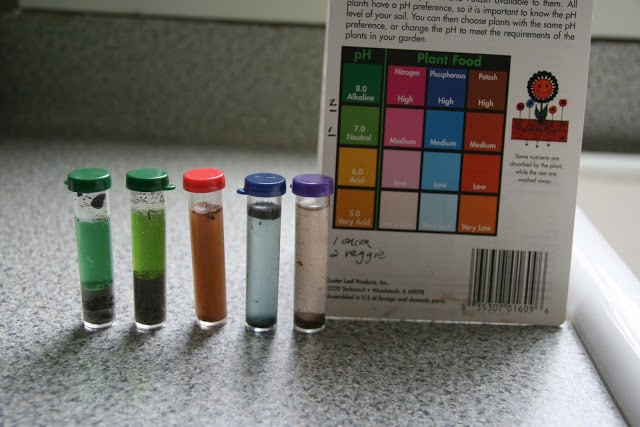Well, I didn’t do that. With the early spring there are veggies (onions) and seeds that need to be planted very soon and I didn’t want to wait for the results, so I bought a cheapie testing kit at the garden center. I doubt these are as accurate as a university analysis, but I was just looking for some general information about the health of my soil in the raised vegetable garden. It’s one of those tests with a lot of little vials and some capsules that you combine with either a small bit of soil (in the case of the pH test) and distilled water or water from a settled soil and distilled water mix.
The results were interesting, although not entirely unexpected.
The first vial you see above, on the far left, was the pH in the main raised vegetable garden bed. As you can see when you compare it to the chart that came with the tests, it was fairly alkaline, probably around 7.6 or so if I had to guess (that’s the disadvantage of these quickie tests, they aren’t specific).
The second vial was the pH of the small raised bed I added last year outside the raised garden that I intend to grow onions in. That soil (almost all of which I added from bags last year and mixed with some homemade compost) is closer to neutral, maybe 7.2 or so.
The middle vial measures potash (or really, potassium) in the soil. I’m most perplexed by this one, because I don’t really know what color that is supposed to be compared to that chart. I’m calling it medium (but it could also be very low … hard to tell). Potassium is the “K” in the NPK numbers you see on fertilizer bags and it’s necessary for plants to flower or fruit and aids with the overall health of a plant. I added some greensand, which also offers some trace minerals, to the garden to help increase this level. Greensand is a mined mineral that is rich in Glauconite.
The fourth vial is phosphorous (the P in NPK) which is important for root development and flowering. You can see that one is hovering in the low or very low territory, so I’ll need to do a little something in that department as well. Phosphate and bone meal are good sources of phosphorous, as is organic matter, but you want to make sure not to overdue this one. Too much phosphorous can interfere with a plant’s ability to absorb important minerals such as zinc and iron. I usually add compost to my beds in spring as soon as I can get at some, so I will probably start there before I add anything else.
And last vial, on the far right, is nitrogen, which you can see is severly lacking. This is not a surprise as soil test almost always show nitrogen is low. Nitrogen, of course, controls the growth rate and even foliage color (to a certain extent) for a plant. Manure, dried blood and urea are all good sources of nitrogen, but again you have to be careful. Too much nitrogen might give you very pretty leaves (although way too much won’t) and lots of them, but it will hinder flowers and fruit and since I grow my tomatoes here, that would be no good at all! I probably won’t take any steps to remedy this at this time, although I will do some light fertilizing to when the plants are growing that should help and I will plant a cover crop that will aid with the nitrogen in the soil in fall.
Do you do soil tests regularly?


